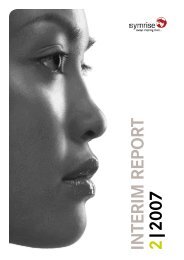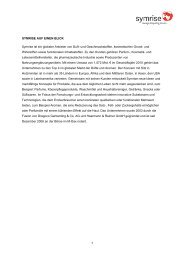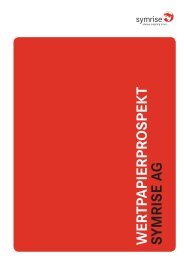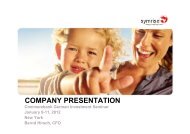THE NATURE OF OUR BUSINESS – STABLE GROWTH - Symrise
THE NATURE OF OUR BUSINESS – STABLE GROWTH - Symrise
THE NATURE OF OUR BUSINESS – STABLE GROWTH - Symrise
You also want an ePaper? Increase the reach of your titles
YUMPU automatically turns print PDFs into web optimized ePapers that Google loves.
If the requirements of IAS 39 with regard to hedge accounting are<br />
fulfilled, <strong>Symrise</strong> AG designates and documents such hedging relationships<br />
thereafter as cash flow hedges. In the case of a cash<br />
flow hedge, variable cash flows to be paid or to be received relating<br />
to a recognized asset or recognized liability or highly probable<br />
future cash flows are hedged. The documentation of the hedging<br />
relationship includes risk management objectives and strategies,<br />
the nature of the hedging relationship, the nature of the risk being<br />
hedged, the relationship between the hedging instrument and the<br />
hedged item and also a description of the method used to assess<br />
the effectiveness of the hedge. The hedging relationships are assessed<br />
as being highly effective in achieving compensation for<br />
risks deriving from changes in fair value or cash flows attributable<br />
to the hedged risk and are regularly examined to ensure whether<br />
they are highly effective during the whole reporting period for<br />
which they are designated.<br />
Changes in the fair value of the derivatives are either recognized<br />
in the result or recognized in equity as a component of other reserves.<br />
Changes in the fair value of derivative instruments that are<br />
allocated to a cash flow hedge are initially recognized in equity in<br />
the amount of the portion that is determined to be an effective<br />
hedge. The ineffective portion of the change in fair value is recognized<br />
directly as part of the financial result. The transfer to the income<br />
statement occurs at the same time as the impact deriving<br />
from the hedged item is recognized in profit or loss.<br />
If derivative financial instruments are not part of, or are no longer<br />
considered to be part of, a hedge accounting relationship because<br />
the conditions for hedge accounting are not fulfilled, or are no<br />
longer fulfilled, then these are classified as held for trading.<br />
The fair value of interest swaps is calculated from the present value<br />
of the future payments, based on publicly quoted interest rates,<br />
using mathematical models for financial valuation.<br />
Non-derivative financial instruments<br />
Non-derivative financial instruments comprise share interests, trade<br />
and other receivables, cash and cash equivalents, and loans as well<br />
as trade and other payables.<br />
Non-derivative financial instruments are initially recognized at their<br />
fair value including any directly attributable transaction costs. This<br />
does not apply to non-derivative financial instruments included in the<br />
category “at fair value through profit and loss,” which are recognized<br />
solely at their fair values, and the transaction costs of which are recognized<br />
directly in profit or loss. Following their initial recognition, nonderivative<br />
financial instruments are treated as follows:<br />
Annual Report 2008 <strong>Symrise</strong> AG 105<br />
Cash and cash equivalents comprise cash balances and call deposits.<br />
Bank overdrafts, which make up a considerable part of the Group’s<br />
cash management facilities are considered to be a component of cash<br />
and cash equivalents for the purposes of the cash flow statement.<br />
Available-for-sale financial assets<br />
<strong>Symrise</strong> holds marketable securities and other available-for-sale<br />
financial assets to a limited extent. Financial assets that are intended<br />
to be held for an indefinite period and which are to be sold<br />
in response to needs for liquidity or changes in interest rates are<br />
classified as available-for-sale and included as noncurrent assets.<br />
However, should management express the intention of selling the<br />
financial assets within twelve months of the balance sheet date, or<br />
should these need to be sold in order to generate liquid funds for<br />
operational purposes, then they are classified as current assets.<br />
Following their initial recognition, they are recorded at their fair<br />
value; all changes in fair value, with the exception of impairment<br />
losses (see note 8.11) and foreign exchange gains and losses on<br />
available-for-sale financial assets (see note 8.6), are recognized<br />
as a component of equity. If an asset is derecognized, the cumulative<br />
gain or loss is transferred from equity to profit or loss.<br />
Financial assets at fair value through profit or loss<br />
A financial instrument is measured at fair value through profit or loss<br />
if it is held for trading or it is designated as such upon initial recognition.<br />
Financial instruments are measured at fair value through<br />
profit and loss when the Group manages these assets and makes decisions<br />
to purchase or sell them based on their value in accordance<br />
with the Group’s documented risk management or investment strategy.<br />
Financial instruments are recognized at their fair value and any<br />
change in their fair value is recognized in profit or loss.<br />
Loans and receivables<br />
The Group’s loans and receivables are financial instruments with<br />
fixed or determinable payments that are not quoted on an active<br />
market. After initial recognition, loans and receivables are recognized<br />
at amortized cost applying the effective interest method,<br />
less any impairment. Amortized costs are determined under consideration<br />
of any premiums or discounts granted at the time of acquisition<br />
and include all charges that form an integral part of the<br />
effective interest rate and transaction costs. Gains and losses are<br />
recognized in the income statement if the loans and receivables<br />
are derecognized, impaired or amortized.<br />
Notes















